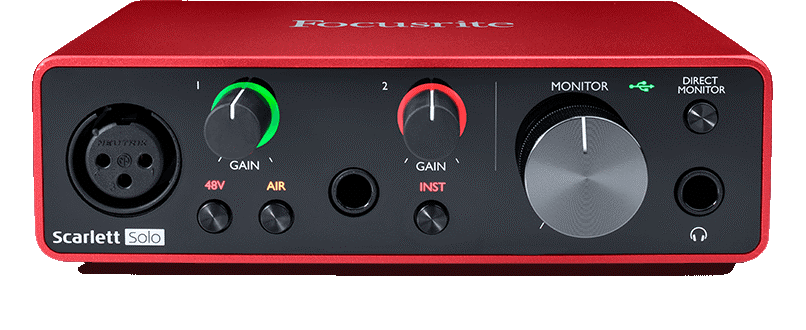“Not Just for Songwriters anymore” by Louis Gentile
The Focusrite Scarlett Solo 3rd Generation is an, “entry-level” part of an extensive line of high-quality audio interfaces. I purchased the Solo after my Black Lion modified mainstay Digi 002r was having compatibility problems with the newer Mac computer I was using. My Digi 002r originally came equipped with Focusrite mic preamps. As with the entire Focusrite line, the Solo features 24-bit/192 kHz resolution.

Focusrite describes the Solo as a “simple” model in their line, geared for singer/songwriters. But since purchasing my 002r, my recording needs have changed and the Solo fits very well. At the time I was doing instrumental Americana library music, which featured mostly live instruments. But since then, like many of us, I have gone onto sample-based, midi-based genres such as orchestral music and sound design. So now I’m basically recording just mono guitars and percussion with a mic, so the Solo’s 1×1 inputs (1 analogue mic input and 1 switchable instrument/line input) fit the bill. Both inputs can be used simultaneously.
The setup is fairly routine, but in order to use all the software features and access the included 3rd party software you need to open an account. The Solo’s on screen display software controls includes sample rate (something that has to be set the same as your DAW setting to sound correct), “Air”, line/instr settings, clock source and Gain Halo colors. A useful feature is the ability to change the Gain Halo colors to suit the user. The unit is solidly built, featuring an all around top, bottom and sides metal case with plastic front and back panels. The front panel control knobs are solidly mounted with no noticeable play. The unit itself is small and portable at 3.8 x 5.7 x 1.7 inches and weighting about a pound. As a result, the front of unit is a little cluttered, but nothing real serious. Something new is the “Air” control. The Focusrite website states that, “Air mode breathes life into vocals, adding unique high-end detail”. I haven’t come to a definite conclusion with this feature and need more time to work with it. But it seems to be useful so far.
The two main issues with the Solo are no mono/stereo switch and no speaker monitor/headphone-muting switch. Both of these were on my 002. Especially for mixing, having the mono/stereo switch is necessary and the monitor/headphone-muting switch is important for an efficient workflow. But similar units in this price range generally don’t include these features. And of course there are work-arounds.
Pros
High-quality Focusrite mic preamp w/Air switch
Sturdy metal case
Switchable Direct Monitoring
Switchable Line/Instrument input
Focusrite/3rd party software included
Bus powered (USB 2.0 and 3.0) includes 3.0 cable
Useful “Focusrite Control” software
Customizable input monitoring Gain Halo colors
USB Connection indicator light
Front mounted mic/line inputs, and switches
Portable enough for out of the studio location recording/sampling
No real problematic latency issues
Cons
No mono/stereo switch
No speaker monitor/headphone-muting switch
Front panel of unit is a little cluttered
In conclusion, the Focusrite Scarlett Solo 3rd Generation sounds good for the most part and is a good deal at the $109 street price. It features a solid casing and sturdy control knobs, quality pre-amps, on screen control software, direct monitoring ability and the new “Air” control. The cons, no mono/stereo switch and no speaker monitor/headphone-muting switch are generally omitted in similar units in this price range. But if you’re doing sample-based, midi-based genres and only need a couple analog inputs, this would be a product worth considering.
Louis Gentile is an internationally accredited composer and sound designer. He has contributed music for CBS’ ‘The Amazing Race’, TLC’s ‘Here Comes Honey Boo Boo’, HULU internet, Amazon Video on Demand, E!’s ‘Chelsea Lately’, Martha Stewart Living’, Discovery, The Science Channel and The Learning Channel. Louis holds a B.A. in Theory and Composition/Performance and has studied film scoring and technology at NYU and Columbia University. He is an adjunct professor of music and has taught Advanced Audio Recording, Midi/ Synthesis and Music Theory, among others.
Here’s a YouTube video review also:
https://www.youtube.com/watch?v=DBAoS05T8TM